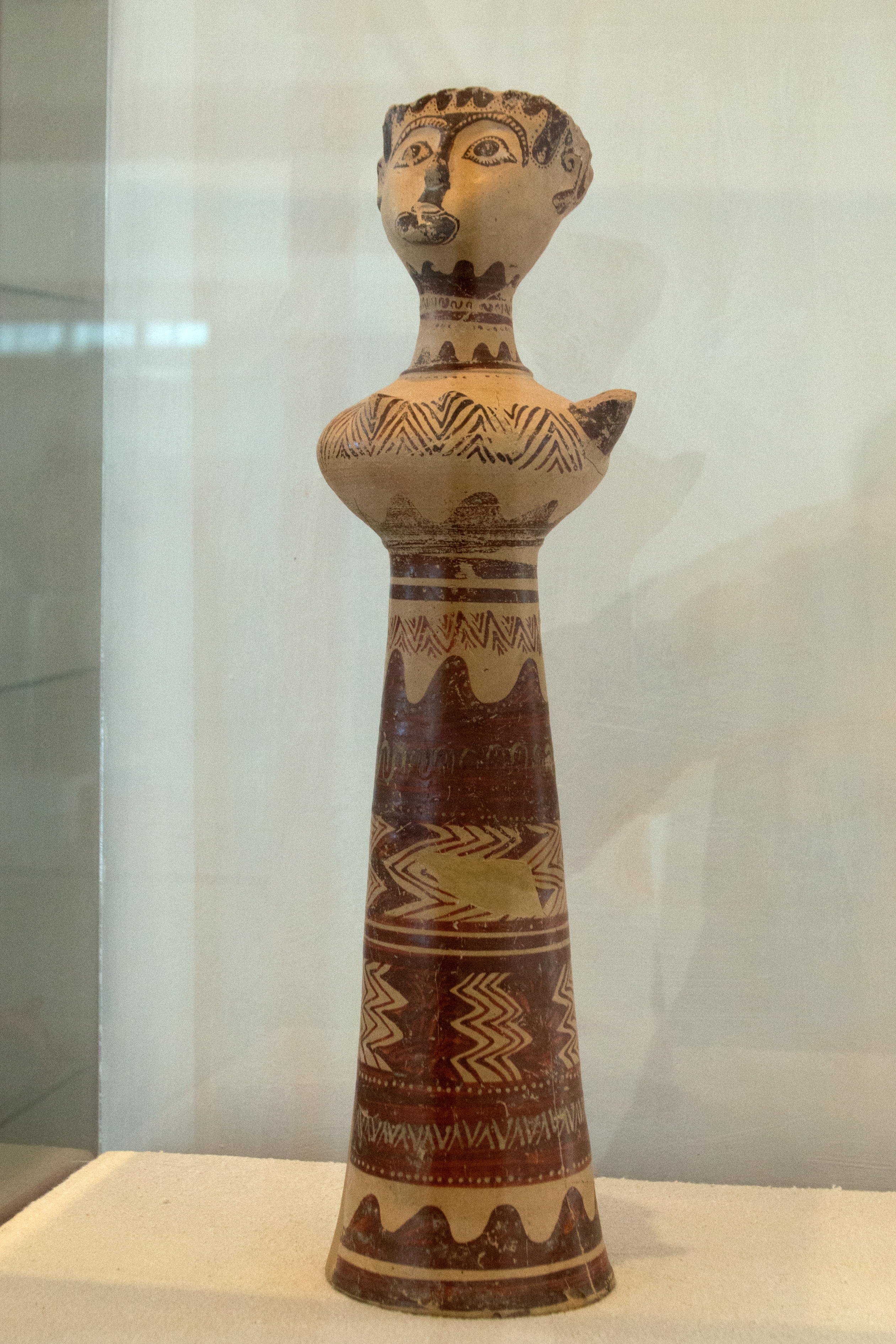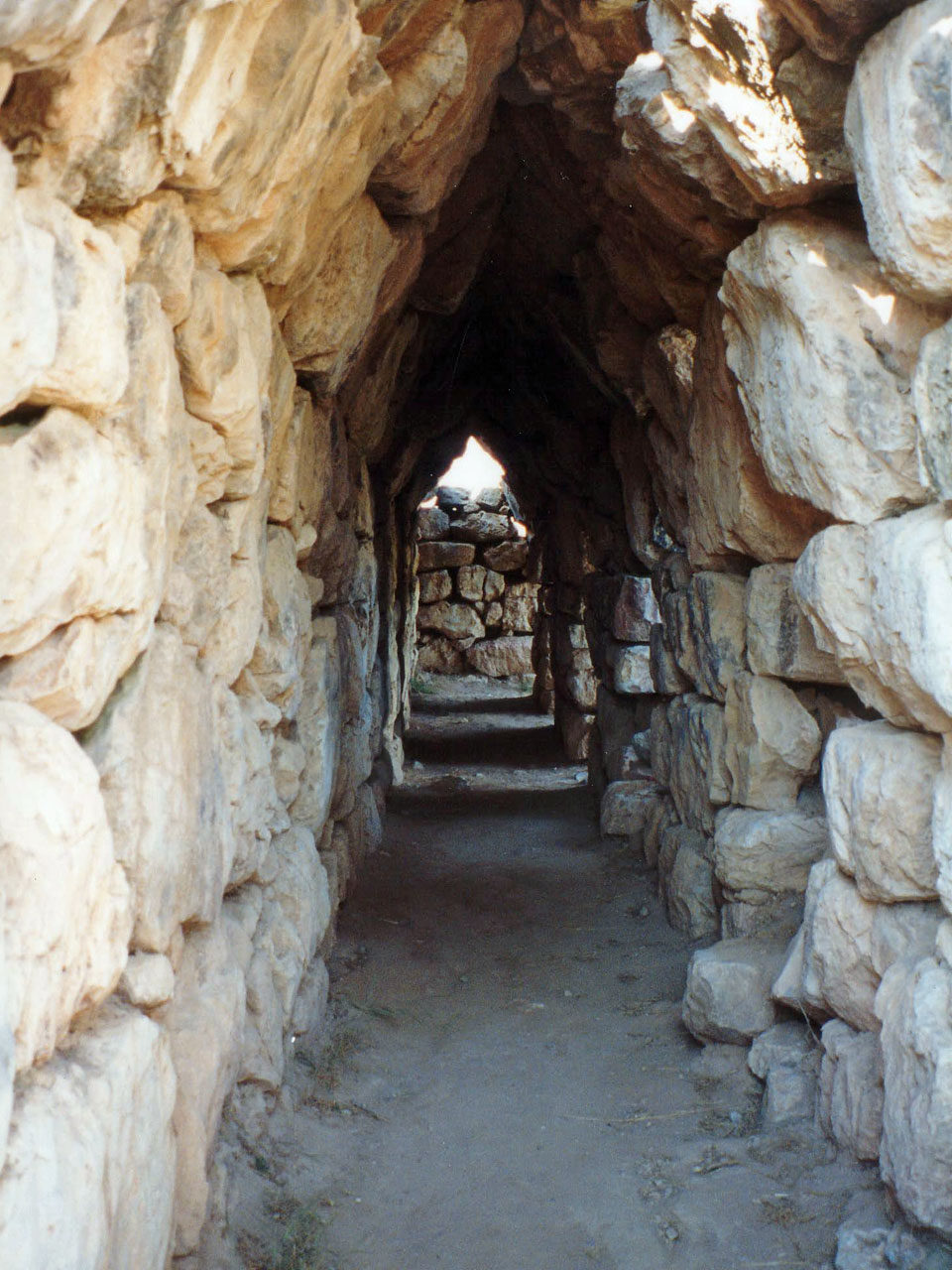|
Aegean Civilization
Aegean civilization is a general term for the Bronze Age civilizations of Greece around the Aegean Sea. There are three distinct but communicating and interacting geographic regions covered by this term: Crete, the Cyclades and the Greek mainland. Crete is associated with the Minoan civilization from the Early Bronze Age. The Cycladic civilization converges with the mainland during the Early Helladic ("Minyan") period and with Crete in the Middle Minoan period. From c. 1450 BC (Late Helladic, Late Minoan), the Greek Mycenaean civilization spreads to Crete, probably by military conquest. The earlier Aegean farming populations of Neolithic Greece brought agriculture to Western Europe already before 5,000 years BC. Aegean Neolithic farmers A DNA study from 2019 indicates that agriculture was brought to Western Europe by the Aegean populations that are known as " Aegean Neolithic farmers". These Neolithic groups arrived to northern France and Germany already around 5000 BC. Ab ... [...More Info...] [...Related Items...] OR: [Wikipedia] [Google] [Baidu] |
Bronze Age Europe
The European Bronze Age is characterized by bronze artifacts and the use of bronze implements. The regional Bronze Age succeeds the Neolithic and Copper Age and is followed by the Iron Age. It starts with the Aegean Bronze Age in 3200 BC (succeeded by the Beaker culture), and spans the entire 2nd millennium BC ( Unetice culture, Tumulus culture, Nordic Bronze Age, Terramare culture, Urnfield culture and Lusatian culture) in Northern Europe, lasting until c. 600 BC. History Aegean The Aegean Bronze Age begins around 3200 BC when civilizations first established a far-ranging trade network. This network imported tin and charcoal to Cyprus, where copper was mined and alloyed with the tin to produce bronze. Bronze objects were then exported far and wide and supported the trade. Isotopic analysis of the tin in some Mediterranean bronze objects indicates it came from as far away as Great Britain. Knowledge of navigation was well developed at this time and reached a pea ... [...More Info...] [...Related Items...] OR: [Wikipedia] [Google] [Baidu] |
Melos
Milos or Melos (; el, label=Modern Greek, Μήλος, Mílos, ; grc, Μῆλος, Mêlos) is a volcanic Greek island in the Aegean Sea, just north of the Sea of Crete. Milos is the southwesternmost island in the Cyclades group. The '' Venus de Milo'' (now in the Louvre) and the '' Asclepius of Milos'' (now in the British Museum) were both found on the island, as were a Poseidon and an archaic Apollo now in Athens. Milos is a popular tourist destination during the summer. The municipality of Milos also includes the uninhabited offshore islands of Antimilos and Akradies. The combined land area is and the 2021 census population was 5193 inhabitants. History Obsidian (a glass-like volcanic rock) from Milos was a commodity as early as 15,000 years ago. Natural glass from Milos was transported over long distances and used for razor-sharp "stone tools" well before farming began and later: "There is no early farming village in the Near East that doesn't get obsidian". The minin ... [...More Info...] [...Related Items...] OR: [Wikipedia] [Google] [Baidu] |
Cyprus
Cyprus ; tr, Kıbrıs (), officially the Republic of Cyprus,, , lit: Republic of Cyprus is an island country located south of the Anatolian Peninsula in the eastern Mediterranean Sea. Its continental position is disputed; while it is geographically in Western Asia, its cultural ties and geopolitics are overwhelmingly Southern European. Cyprus is the third-largest and third-most populous island in the Mediterranean. It is located north of Egypt, east of Greece, south of Turkey, and west of Lebanon and Syria. Its capital and largest city is Nicosia. The northeast portion of the island is ''de facto'' governed by the self-declared Turkish Republic of Northern Cyprus, which was established after the 1974 invasion and which is recognised as a country only by Turkey. The earliest known human activity on the island dates to around the 10th millennium BC. Archaeological remains include the well-preserved ruins from the Hellenistic period such as Salamis and Kourion, ... [...More Info...] [...Related Items...] OR: [Wikipedia] [Google] [Baidu] |
Troad
The Troad ( or ; el, Τρωάδα, ''Troáda'') or Troas (; grc, Τρῳάς, ''Trōiás'' or , ''Trōïás'') is a historical region in northwestern Anatolia. It corresponds with the Biga Peninsula ( Turkish: ''Biga Yarımadası'') in the Çanakkale province of modern Turkey. Bounded by the Dardanelles to the northwest, by the Aegean Sea to the west and separated from the rest of Anatolia by the massif that forms Mount Ida, the Troad is drained by two main rivers, the Scamander ( Karamenderes) and the Simois, which join at the area containing the ruins of Troy. Mount Ida, called by Homer "many-fountain" (πολυπίδαξ), sourced several rivers, including Rhesos, Heptaporos, Caresus, Rhodios, Granicus (Granikos), Aesepus, Skamandros and Simoeis liad 12.18 ff these rivers were deified as a source of life by the Greeks, who depicted them on their coins as river-gods reclining by a stream and holding a reed. History The Troad gets its name from the Hittites' name ... [...More Info...] [...Related Items...] OR: [Wikipedia] [Google] [Baidu] |
Tiryns
Tiryns or (Ancient Greek: Τίρυνς; Modern Greek: Τίρυνθα) is a Mycenaean archaeological site in Argolis in the Peloponnese, and the location from which the mythical hero Heracles performed his Twelve Labours. It lies south of Mycenae. Tiryns was a hill fort with occupation ranging back seven thousand years, from before the beginning of the Bronze Age. It reached its height of importance between 1400 and 1200 BC, when it became one of the most important centers of the Mycenaean world, and in particular in Argolis. Its most notable features were its palace, its Cyclopean tunnels and especially its walls, which gave the city its Homeric epithet of "mighty walled Tiryns". Tiryns became associated with the myths surrounding Heracles, as the city was the residence of the hero during his labors, and some sources cite it as his birthplace. The famous megaron of the palace of Tiryns has a large reception hall, the main room of which had a throne placed against the ... [...More Info...] [...Related Items...] OR: [Wikipedia] [Google] [Baidu] |
Mycenae
Mycenae ( ; grc, Μυκῆναι or , ''Mykē̂nai'' or ''Mykḗnē'') is an archaeological site near Mykines in Argolis, north-eastern Peloponnese, Greece. It is located about south-west of Athens; north of Argos; and south of Corinth. The site is inland from the Saronic Gulf and built upon a hill rising above sea level. In the second millennium BC, Mycenae was one of the major centres of Greek civilization, a military stronghold which dominated much of southern Greece, Crete, the Cyclades and parts of southwest Anatolia. The period of Greek history from about 1600 BC to about 1100 BC is called Mycenaean in reference to Mycenae. At its peak in 1350 BC, the citadel and lower town had a population of 30,000 and an area of 32 hectares. The first correct identification of Mycenae in modern literature was during a survey conducted by Francesco Grimani, commissioned by the Provveditore Generale of the Kingdom of the Morea in 1700, who used Pausanias's description of ... [...More Info...] [...Related Items...] OR: [Wikipedia] [Google] [Baidu] |
Cape Gelidonya
Cape Gelidonya ( tr, Gelidonya Burnu or Taşlık Burnu, from el, Χελιδωνία, ''Chelidonia''; la, Chelidonium promontorium), formerly Kilidonia or Killidonia is a cape or headland on the Teke Peninsula in the chain of Taurus Mountains, located on the southern coast of Anatolia between the Gulf of Antalya and the Bay of Finike. During the classical Greek and Hellenistic eras, it was called Chelidonia (meaning swallows), and a group of five small islands, as Chelidoniai nesoi (Swallow Islands, now Beşadalar Adasi). In Roman times, it was known as ''Promontorium Sacrum'' ( Latin for "Holy Promontory"), and the group of islands as Chelidoniae Insulae. Bronze Age shipwreck The cape is the site of a late Bronze Age shipwreck (c. 1200 BC). In view of the cargo's nature and composition the findings are of a Mycenean Greek provenance. The remains of the ship sat at a depth of about , on irregular rocky bottom. It was located in 1954, and the excavation began in 1960 by Peter Th ... [...More Info...] [...Related Items...] OR: [Wikipedia] [Google] [Baidu] |
Uluburun
The Uluburun Shipwreck is a Late Bronze Age shipwreck dated to the late 14th century BC, discovered close to the east shore of Uluburun (Grand Cape), Turkey, in the Mediterranean Sea. The shipwreck was discovered in the summer of 1982 by Mehmed Çakir, a local sponge diver from Yalıkavak, a village near Bodrum. Eleven consecutive campaigns of three to four months' duration took place from 1984 to 1994 totaling 22,413 dives, revealing one of the most spectacular Late Bronze Age assemblages to have emerged from the Mediterranean Sea. Discovery The shipwreck site was discovered in the summer of 1982 due to Mehmet Çakir's sketching of “the metal biscuits with ears” recognized as oxhide ingots. Turkish sponge divers were often consulted by the Institute of Nautical Archaeology's (INA) survey team on how to identify ancient wrecks while diving for sponges. Çakir's findings urged Oğuz Alpözen, Director of the Bodrum Museum of Underwater Archaeology, to send out an inspection ... [...More Info...] [...Related Items...] OR: [Wikipedia] [Google] [Baidu] |
Akrotiri (prehistoric City)
Akrotiri (Greek: Ακρωτήρι, pronounced ) was a Cycladic Bronze Age settlement on the volcanic Greek island of Santorini (Thera). The settlement was destroyed in the Theran eruption sometime in the 16th century BC and buried in volcanic ash, which preserved the remains of fine frescoes and many objects and artworks. Akrotiri has been excavated since 1967 after earlier excavations on Santorini. History The earliest evidence for human habitation of Akrotiri can be traced back as early as the fifth millennium BC, when it was a small fishing and farming village. By the end of the third millennium, this community developed and expanded significantly. One factor for Akrotiri's growth may be the trade relations it established with other cultures in the Aegean, as evidenced in fragments of foreign pottery at the site. Akrotiri's strategic position on the primary sailing route between Cyprus and Minoan Crete also made it an important point for the copper trade, thus allowing it to ... [...More Info...] [...Related Items...] OR: [Wikipedia] [Google] [Baidu] |
Mast (sailing)
The mast of a sailing vessel is a tall spar, or arrangement of spars, erected more or less vertically on the centre-line of a ship or boat. Its purposes include carrying sails, spars, and derricks, and giving necessary height to a navigation light, look-out position, signal yard, control position, radio aerial or signal lamp. Large ships have several masts, with the size and configuration depending on the style of ship. Nearly all sailing masts are guyed. Until the mid-19th century, all vessels' masts were made of wood formed from a single or several pieces of timber which typically consisted of the trunk of a conifer tree. From the 16th century, vessels were often built of a size requiring masts taller and thicker than could be made from single tree trunks. On these larger vessels, to achieve the required height, the masts were built from up to four sections (also called masts). From lowest to highest, these were called: lower, top, topgallant, and royal masts. Giving the ... [...More Info...] [...Related Items...] OR: [Wikipedia] [Google] [Baidu] |
Frying Pans
Frying pans is the descriptive name for Early Cycladic II artifacts from the Aegean Islands, flat skillets with a "handle", usually made from earthenware but sometimes stone ( Frying pan (Karlsruhe 75/11) is an example). They are found especially during the Cycladic Grotta-Pelos and Keros-Syros cultures. Their purpose remains unknown, although they are usually interpreted as prestige goods. Their backsides are typically highly decorated and were apparently carefully crafted. They have been found at sites throughout the Aegean but are not common: around 200 have been unearthed to date, all but a handful in pottery. They are usually found in graves, although they are very uncommon grave goods; the rarity of these objects has contributed to the difficulty in identifying their true purpose. Description Frying pans typically resemble skillets (hence the name ''frying pan'') in that they have a diameter of , a raised lip and a handle. However, all the decoration tends to be on ... [...More Info...] [...Related Items...] OR: [Wikipedia] [Google] [Baidu] |
Epistolary Novel
An epistolary novel is a novel written as a series of letters. The term is often extended to cover novels that intersperse documents of other kinds with the letters, most commonly diary entries and newspaper clippings, and sometimes considered to include novels composed of documents even if they don't include letters at all. More recently, epistolaries may include electronic documents such as recordings and radio, blog posts, and e-mails. The word ''epistolary'' is derived from Latin from the Greek word ἐπιστολή ''epistolē'', meaning a letter (see epistle). In German, this type of novel is known as a Briefroman. The epistolary form can add greater realism to a story, because it mimics the workings of real life. It is thus able to demonstrate differing points of view without recourse to the device of an omniscient narrator. An important strategic device in the epistolary novel for creating the impression of authenticity of the letters is the fictional editor. Early ... [...More Info...] [...Related Items...] OR: [Wikipedia] [Google] [Baidu] |


.jpg)

.jpg)

.jpg)

